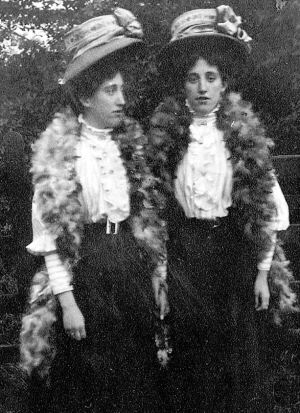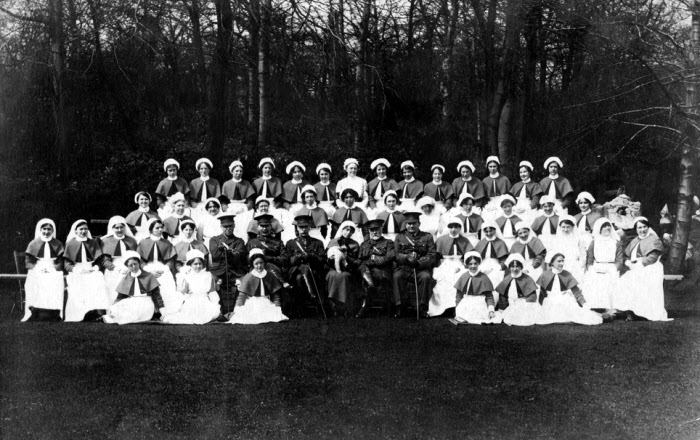
Clara Renshaw and her twin sister, Elsie, were born at Roundwood on August 30th 1890 to William and Elizabeth (née Audsley). William was an engine man at Old Roundwood Pit and he and Elizabeth had married in Ossett in 1878. Remarkably all of the nine children born to the couple survived until at least 1911. As well as their twin daughters they had seven other children; Fred (1878-1914), Polly (1880-1960), Joseph (1883-1968), Edith (1885-1955), Alfred (1888-1974), Annie (1893-1970) and Lizzie (1897-1974).
During WW1, Clara became a Voluntary Aid Detachment (VAD) nurse. Women had to be between 21 and 48 years of age for Home Service, and between 23 and 42 for Foreign Service. Clara was 28. As twins are said to have an extraordinary close bond, one might expect Clara and Elsie to have registered together but Elsie had married 26 year old Harry Wilby in July 1915 and they had their first child Clara the following year. A second child, Albert, was born to the couple in late 1922.
By 1918 there were over 90,000 British Red Cross VADs and over two and a half million sick and wounded soldiers were treated in hospitals in the UK alone between 1914 and 1919. From November 19th 1917 to June 21st 1918, Clara was stationed at one of the Military Hospitals in Newport, Cardiff. VAD nurses were appointed on probation for one month then, if they were recommended for further service, they could either sign up for a further six months or for the duration of the war. Though many declined a salary, VAD nurses were paid £20 a year and granted 7 days leave. Further service granted them £22.10s a year and their leave was doubled. After her seven months in Cardiff, Clara transferred to Huddersfield, to a Military Hospital closer to home, and was stationed there until December 15th 1918. The main Military Hospital in Huddersfield was Royds Hall where 22,000 patients were treated. Royds Hall had the lowest death rate (75 across its lifespan) of any war hospital in the country.
In June 1918 Clara returned home to 55 Belmont Terrace, South Parade and to her job in a local mill. Belmont Terrace is the row of houses on the right side of the junction of Fairfield Road and South Parade. On June 23 1923 Clara married John William Robinson at the Primitive Methodist Chapel, Ossett Common. John was a farmer and lived at Cardigan Lane, Manor Road, Ossett. After their marriage Clara and John lived at Elmroyd Farm, Thornhill Road, Wakefield. Their only child Elsie was born in 1924.

Above: Nursing staff at the Royds Hall Military Hospital during WW1. Could Clara Renshaw be in this picture?
In 1939 Clara and John William Robinson were still living at the Emroyd Farm address and John was working as a private hire car driver. The 1939 register records a redacted name in the household which is likely to be their 15 year old daughter, Elsie. In early 1968 there is a Dewsbury death registration record for Clara Robinson , aged 77 years. Clara’s twin, Elsie, had married Harry Wilby in 1915 and in 1939 the couple were living at “Renwil” Kingsway, Ossett with their two children, Clara and Albert. Both children worked for a local wagon company; Clara as a filing clerk and Albert as an apprentice fitter. In early 1958 there is a Lower Agbrigg (then the Registry Office for Ossett) death registration record for Elsie Wilby, aged 67 years.

The twins’ eldest brother, Fred, a pit pony driver, died in summer 1914 aged 36 years. His death was registered in Dewsbury district and his name is not included on the Roll Of Honour of Employees of Ossett Roundwood Collieries who served in The Great War 1914-1919. The name J. Renshaw is included on the Roll Of Honour which, to this day, is displayed in Ossett Town Hall. This could be the twins’ brother, Joseph, who was a hurrier at Roundwood.
In August 1918, Joseph Renshaw, 5’ 9” tall and weighing 130 lbs, was a collier working for Terry, Greaves & Co at Old Roundwood Colliery, Ossett and living at 55 Belmont Terrace, Ossett. Joseph was called up on August 8th 1918 (although he was deemed to have enlisted in early March 1916) when he was posted to the 49th Recruit Distribution battalion Training Reserve. He was examined at Liverpool (Prees Heath)and in the ordinary course of events would have been expected to have joined the 15th (Reserve) Bn. King’s (Liverpool) Regiment. His service record suggested he was slightly deaf, needed dental treatment and had a faulty cartilage in his right knee. In late August he was confined to barracks for 3 days for having a dirty rifle and a week later he was confined again for being late for parade falling in. In early October 1918 he was transferred to reserve and discharged on his demobilisation at Preston in January 1919.
References
1. Ossett Through The Ages (OTTA) Facebook posts.
2. Photographs supplied by Ian Blythe as a follow-up to the OTTA Clara Renshaw post.